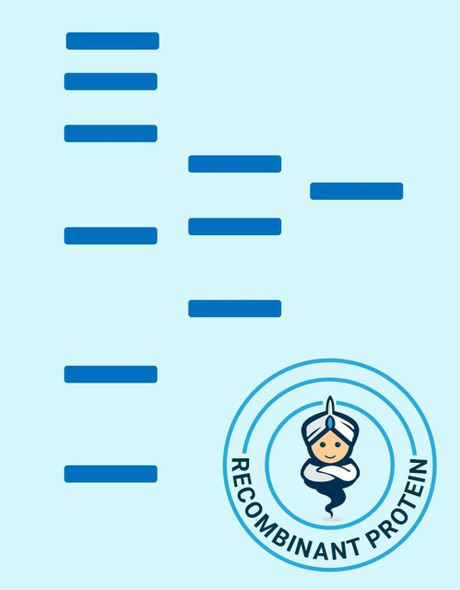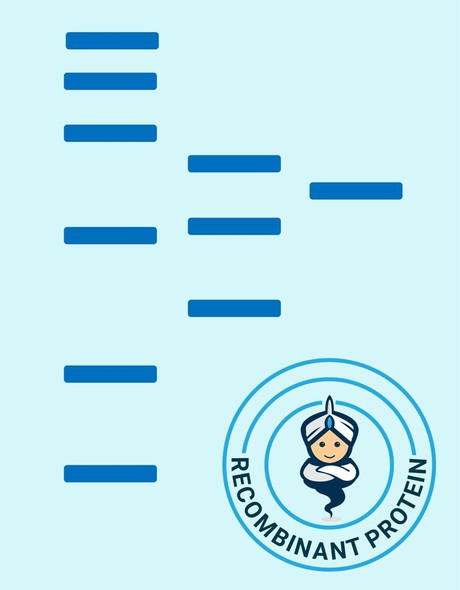Hormones Recombinant Proteins
Human GCGR Recombinant Protein (RPPB1279)
- SKU:
- RPPB1279
- Product Type:
- Recombinant Protein
- Species:
- Human
- Uniprot:
- P47871
- Research Area:
- Hormones
Description
| Product Name: | Human GCGR Recombinant Protein |
| Product Code: | RPPB1279 |
| Size: | 10µg |
| Species: | Human |
| Target: | GCGR |
| Synonyms: | GL-R, GLR, Glucagon Receptor. |
| Source: | Escherichia Coli |
| Physical Appearance: | Filtered White lyophilized (freeze-dried) powder. |
| Formulation: | GCGR filtered (0.4 �m) and lyophilized from solution in acetonitrile/0,1%TFA and 1% (w/v) trehalose. |
| Solubility: | It is recommended to add 200�l deionized water to prepare a working stock solution of approximately 0.5mg/ml and let the lyophilized pellet dissolve completely. GCGR is not sterile! Please filter the product by an appropriate sterile filter before using it in the cell culture. |
| Stability: | Store lyophilized protein at -20°C. Aliquot the product after reconstitution to avoid repeated freezing/thawing cycles. Reconstituted protein can be stored at 4°C for a limited period of time; it does not show any change after one week at 4°C. |
| Purity: | Greater than 95.0% as determined by SDS-PAGE. |
| Amino Acid Sequence: | MQVMDFLFEK WKLYGDQCHH NLSLLPPPTE LVCNRTFDKY SCWPDTPANT TANISCPWYL PWHHKVQHRF VFKRCGPDGQ WVRGPRGQPW RDASQCQMDG EEIEVQKEVA KMYSSFQLEH HHHHH |
Glucagon receptor is part of the glucagon receptor family which also contains GLP-1, GLP-2, GHRH and GIP receptors. GCGR regulates blood glucose levels and is mainly expressed in the pancreas, liver and kidneys. Mutations in GCGR are a cause of non-insulin-dependent diabetes mellitus.�
GCGR Human Recombinant produced in E. coli is a single, non-glycosylated polypeptide chain (a.a 27-142) containing 125 amino acids including a 9 a.a C-terminal His tag. The total molecular mass is 14.9kDa (calculated).�
| UniProt Protein Function: | GCGR: This is a receptor for glucagon which plays a central role in regulating the level of blood glucose by controlling the rate of hepatic glucose production and insulin secretion. The activity of this receptor is mediated by G proteins which activate adenylyl cyclase and also a phosphatidylinositol-calcium second messenger system. Belongs to the G-protein coupled receptor 2 family. |
| UniProt Protein Details: | Protein type:Membrane protein, multi-pass; GPCR, family 2; Membrane protein, integral; Receptor, GPCR Chromosomal Location of Human Ortholog: 17q25 Cellular Component: integral to membrane; integral to plasma membrane; plasma membrane Molecular Function:glucagon receptor activity; guanyl-nucleotide exchange factor activity Biological Process: G-protein signaling, coupled to cAMP nucleotide second messenger; generation of precursor metabolites and energy; glucose homeostasis; regulation of blood pressure; response to nutrient; response to starvation Disease: Diabetes Mellitus, Noninsulin-dependent |
| NCBI Summary: | The protein encoded by this gene is a glucagon receptor that is important in controlling blood glucose levels. Defects in this gene are a cause of non-insulin-dependent diabetes mellitus (NIDDM).[provided by RefSeq, Jan 2010] |
| UniProt Code: | P47871 |
| NCBI GenInfo Identifier: | 1346144 |
| NCBI Gene ID: | 2642 |
| NCBI Accession: | P47871.1 |
| UniProt Secondary Accession: | P47871,Q2M3M5, |
| UniProt Related Accession: | P47871 |
| Molecular Weight: | 54,009 Da |
| NCBI Full Name: | Glucagon receptor |
| NCBI Synonym Full Names: | glucagon receptor |
| NCBI Official Symbol: | GCGR�� |
| NCBI Official Synonym Symbols: | GGR; GL-R�� |
| NCBI Protein Information: | glucagon receptor |
| UniProt Protein Name: | Glucagon receptor |
| Protein Family: | Glucagon receptor |
| UniProt Gene Name: | GCGR�� |
| UniProt Entry Name: | GLR_HUMAN |






